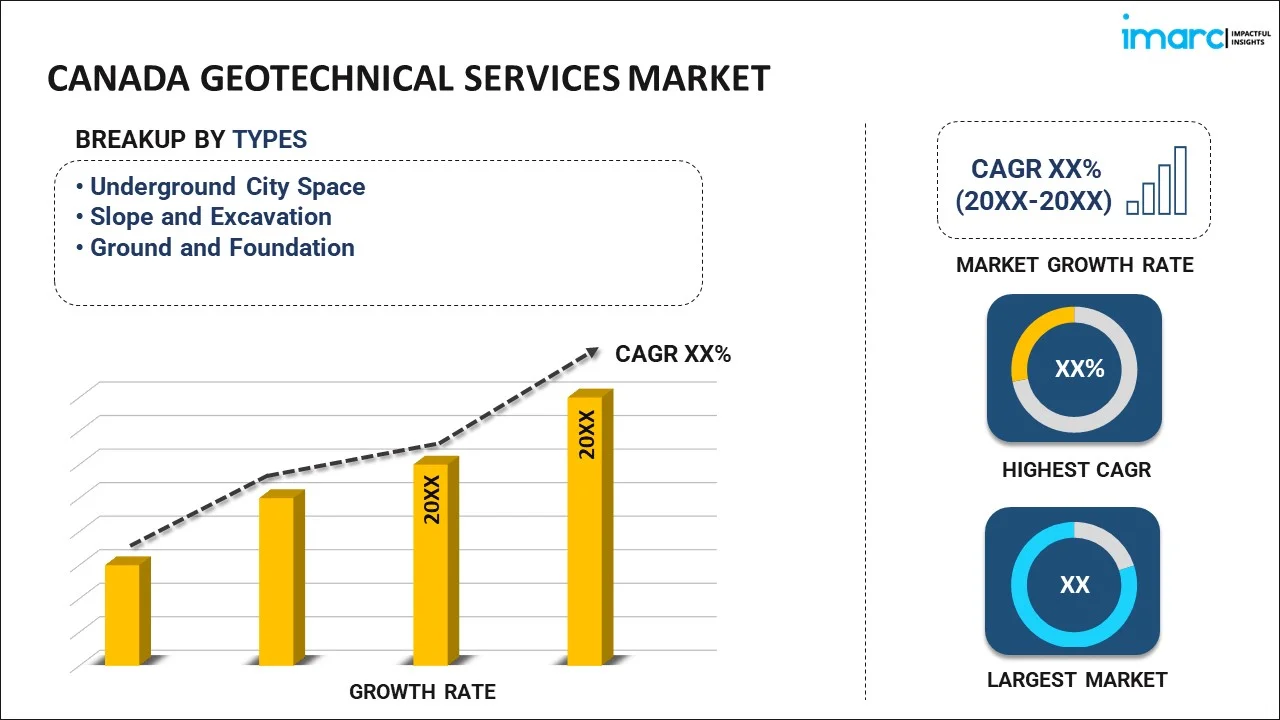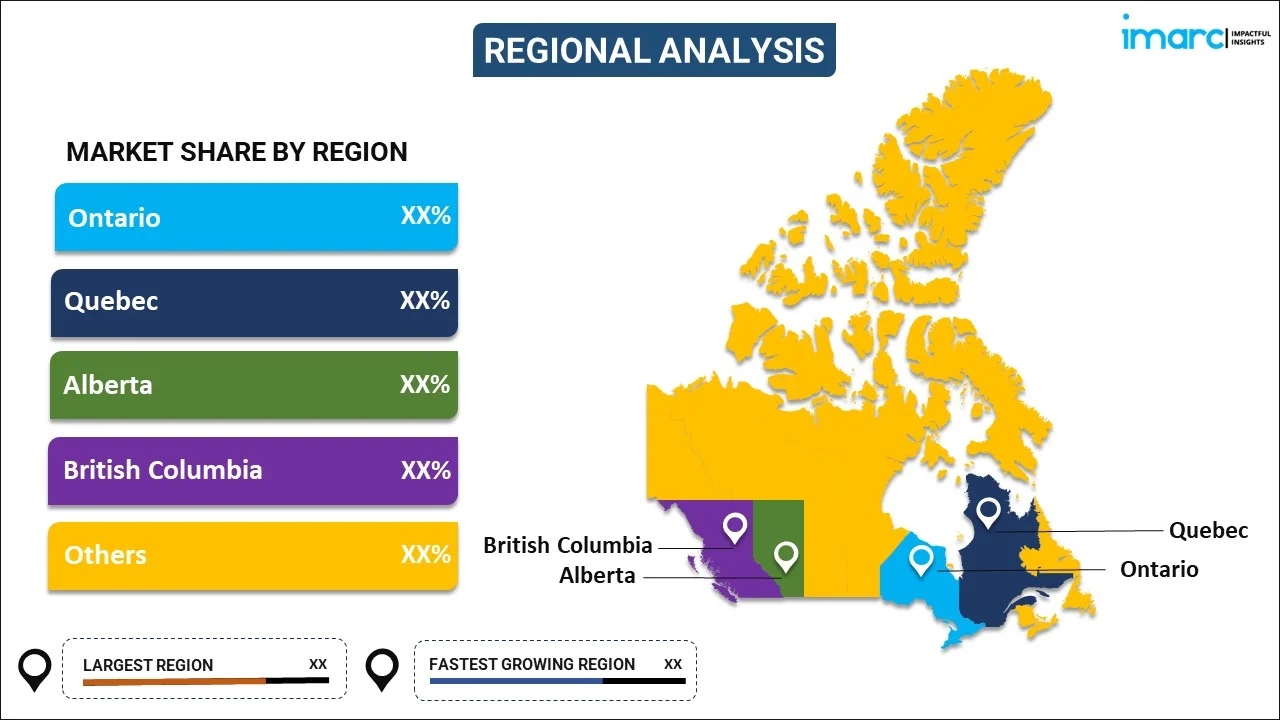
Canada Geotechnical Services Market Report by Type (Underground City Space, Slope and Excavation, Ground and Foundation), End-User (Municipal, Bridge and Tunnel, Oil and Gas, Mining, Marine, Building Construction, and Others), and Region 2024-2032
Canada Geotechnical Services Market Overview:
The Canada geotechnical services market is projected to exhibit a growth rate (CAGR) of 7.10% during 2024-2032. The market is experiencing growth due to infrastructure development in transportation, energy, and urban sectors. Technological advancements, including GIS and remote sensing, enhance project accuracy. The demand for services, crucial for assessing ground conditions and foundation design, is rising in tandem with construction activities, which, in turn, is contributing to the market growth.
|
Report Attribute
|
Key Statistics
|
|---|---|
|
Base Year
|
2023 |
|
Forecast Years
|
2024-2032
|
|
Historical Years
|
2018-2023
|
| Market Growth Rate (2024-2032) | 7.10% |
Canada Geotechnical Services Market Trends:
Rising Focus on Infrastructure Development
Canada’s growing infrastructure development spanning across transportation, energy and urban expansion initiatives is fueling a heightened demand for geotechnical services. For instance, according to an article published by Government of Canada in June 2024 the government of Canada and Quebec have announced the renewal of the Canada Community Building Fund (CCBF) for the 2024-2034 period. Quebec will receive over $2.8 billion in CCBF funding over the next five years including $535 million for the 2024-2025 fiscal year. This investment will support infrastructure projects across 19 different categories, such as drinking water, wastewater, public transit and community energy systems. Overall, the federal government is investing $26.7 billion over the next ten years to support core infrastructure projects nationwide. Geotechnical services play an important role in evaluating ground conditions, stability and foundation design for large scale infrastructure endeavors. Geotechnical assessments are indispensable for identifying potential risks and optimizing construction plans to ensure high integrity and longevity. As the nation invests in upgrading aging infrastructure and undertaking ambitious projects to meet evolving social needs the need for accurate geotechnical data and expertise becomes increasingly paramount.
Technological Advancements
The integration of cutting-edge technologies like GIS, remote sensing and geospatial analysis has revolutionized geotechnical investigations in Canada. For instance, in April 2024, Fission Uranium Corp. started geotechnical drilling at its PLS high-grade uranium mine and mill project in Saskatchewan, Canada. The drilling program will support the Detailed Engineering design of the waste management and landfill facility, tailings management facility, and ventilation shafts. This development will allow the company to finalize engineering designs and move forward with the procurement, fabrication, and construction of various components. By harnessing these tools engineers nowadays can accurately assess terrain conditions, identify geological features and analyze data with unprecedented precision and efficiency. Geographic information systems enable the visualization and interpretation of spatial data facilitating informed decision making in project planning and risk assessment. In line with this, remote sensing techniques provide valuable insights into surface characteristics and subsurface structures aiding in site characterization and hazard identification. Furthermore, innovative technology such as LiDAR and ground penetrating radar offers noninvasive methods for mapping terrain topography and detecting underground features.
Canada Geotechnical Services Market News:
- In May 2024, Fugro was contracted by In June 2024, Colliers announced its acquisition of Englobe Corp. for 475 million U.S. dollar making its entry into Canadian engineering services sector. The Quebec-based company offers civil, geotechnical and environmental engineering services. Following the acquisition, in globe will be rebranded as Colliers.
- TYLin to provide geotechnical interpretation and consulting services for detailed design phase of the Île d'Orléans Bridge project in Québec, Canada. The project aims to replace a 1935 suspension bridge spanning the St. Lawrence River and improved transportation for residents and businesses.
Canada Geotechnical Services Market Segmentation:
IMARC Group provides an analysis of the key trends in each segment of the market, along with forecasts at the country level for 2024-2032. Our report has categorized the market based on type and end-user.
Type Insights:

- Underground City Space
- Slope and Excavation
- Ground and Foundation
The report has provided a detailed breakup and analysis of the market based on the type. This includes underground city space, slope and excavation, and ground and foundation.
End-User Insights:
- Municipal
- Bridge and Tunnel
- Oil and Gas
- Mining
- Marine
- Building Construction
- Others
A detailed breakup and analysis of the market based on the end-user have also been provided in the report. This includes municipal, bridge and tunnel, oil and gas, mining, marine, building construction, and others.
Regional Insights:

- Ontario
- Quebec
- Alberta
- British Columbia
- Others
The report has also provided a comprehensive analysis of all the major regional markets, which include Ontario, Quebec, Alberta, British Columbia, Others.
Competitive Landscape:
The market research report has also provided a comprehensive analysis of the competitive landscape. Competitive analysis such as market structure, key player positioning, top winning strategies, competitive dashboard, and company evaluation quadrant has been covered in the report. Also, detailed profiles of all major companies have been provided.
Canada Geotechnical Services Market Report Coverage:
| Report Features | Details |
|---|---|
| Base Year of the Analysis | 2023 |
| Historical Period | 2018-2023 |
| Forecast Period | 2024-2032 |
| Units | Million US$ |
| Scope of the Report | Exploration of Historical Trends and Market Outlook, Industry Catalysts and Challenges, Segment-Wise Historical and Future Market Assessment:
|
| Types Covered | Underground City Space, Slope and Excavation, Ground and Foundation |
| End-Users Covered | Municipal, Bridge and Tunnel, Oil and Gas, Mining, Marine, Building Construction, Others |
| Regions Covered | Ontario, Quebec, Alberta, British Columbia, Others |
| Customization Scope | 10% Free Customization |
| Post-Sale Analyst Support | 10-12 Weeks |
| Delivery Format | PDF and Excel through Email (We can also provide the editable version of the report in PPT/Word format on special request) |
Key Questions Answered in This Report:
- How has the Canada geotechnical services market performed so far and how will it perform in the coming years?
- What has been the impact of COVID-19 on the Canada geotechnical services market?
- What is the breakup of the Canada geotechnical services market on the basis of type?
- What is the breakup of the Canada geotechnical services market on the basis of end-user?
- What are the various stages in the value chain of the Canada geotechnical services market?
- What are the key driving factors and challenges in the Canada geotechnical services?
- What is the structure of the Canada geotechnical services market and who are the key players?
- What is the degree of competition in the Canada geotechnical services market?
Key Benefits for Stakeholders:
- IMARC’s industry report offers a comprehensive quantitative analysis of various market segments, historical and current market trends, market forecasts, and dynamics of the Canada geotechnical services market from 2018-2032.
- The research report provides the latest information on the market drivers, challenges, and opportunities in the Canada geotechnical services market.
- Porter's five forces analysis assist stakeholders in assessing the impact of new entrants, competitive rivalry, supplier power, buyer power, and the threat of substitution. It helps stakeholders to analyze the level of competition within the Canada geotechnical services industry and its attractiveness.
- Competitive landscape allows stakeholders to understand their competitive environment and provides an insight into the current positions of key players in the market.
Need more help?
- Speak to our experienced analysts for insights on the current market scenarios.
- Include additional segments and countries to customize the report as per your requirement.
- Gain an unparalleled competitive advantage in your domain by understanding how to utilize the report and positively impacting your operations and revenue.
- For further assistance, please connect with our analysts.
 Inquire Before Buying
Inquire Before Buying
 Speak to an Analyst
Speak to an Analyst
 Request Brochure
Request Brochure
 Request Customization
Request Customization




.webp)




.webp)












